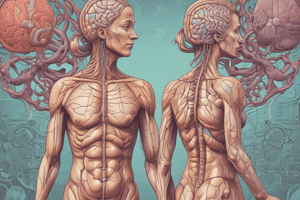Podcast
Questions and Answers
What is the primary cause of hypernatremia in nonketotic hyperosmolar hyperglycemic coma of diabetes?
What is the primary cause of hypernatremia in nonketotic hyperosmolar hyperglycemic coma of diabetes?
- Renal insufficiency
- Inadequate production of antidiuretic hormone
- Excess loss of sodium ions
- Hyperglycemia-induced osmotic diuresis (correct)
What is the result of renal insufficiency in relation to hypernatremia?
What is the result of renal insufficiency in relation to hypernatremia?
- Decreased sodium reabsorption
- Enhanced sodium retention
- Impaired ability to concentrate urine (correct)
- Increased sodium excretion
What is the consequence of excess water loss without adequate replacement?
What is the consequence of excess water loss without adequate replacement?
- Hypernatremia (correct)
- Electrolyte imbalance
- Fluid overload
- Hyponatremia
What is the characteristic of diabetes insipidus?
What is the characteristic of diabetes insipidus?
What is the result of taking loop diuretics?
What is the result of taking loop diuretics?
What is the consequence of hypernatremia without disturbance in sodium balance?
What is the consequence of hypernatremia without disturbance in sodium balance?
What is the characteristic of a patient with diabetes insipidus?
What is the characteristic of a patient with diabetes insipidus?
What is a common cause of hypernatremia?
What is a common cause of hypernatremia?
What is a common characteristic of the elderly population that contributes to hypernatremia?
What is a common characteristic of the elderly population that contributes to hypernatremia?
What is the primary cause of inappropriate ADH secretion in SIADH?
What is the primary cause of inappropriate ADH secretion in SIADH?
What is the primary goal of treating hypernatremia?
What is the primary goal of treating hypernatremia?
Which of the following is a sign or symptom of hypernatremia?
Which of the following is a sign or symptom of hypernatremia?
Which of the following conditions is associated with increased release of ADH?
Which of the following conditions is associated with increased release of ADH?
What is the effect of SIADH on urine production?
What is the effect of SIADH on urine production?
What is the term for the shrinkage of the brain stem that occurs in hypernatremia?
What is the term for the shrinkage of the brain stem that occurs in hypernatremia?
What is the term for the type of hypernatremia that occurs with decreased total body water (TBW) and increased sodium levels?
What is the term for the type of hypernatremia that occurs with decreased total body water (TBW) and increased sodium levels?
Which of the following is a cause of renal losses?
Which of the following is a cause of renal losses?
What is the effect of diuretics on urine production?
What is the effect of diuretics on urine production?
What is the treatment for hypernatremia in a patient who cannot drink water?
What is the treatment for hypernatremia in a patient who cannot drink water?
What is a common underlying cause of hypernatremia in the elderly population?
What is a common underlying cause of hypernatremia in the elderly population?
Which of the following is a cause of non-renal losses?
Which of the following is a cause of non-renal losses?
What is the effect of glucocorticoid deficiency on ADH secretion?
What is the effect of glucocorticoid deficiency on ADH secretion?
What is the term for the type of hypernatremia that occurs with increased total body water (TBW) and increased sodium levels?
What is the term for the type of hypernatremia that occurs with increased total body water (TBW) and increased sodium levels?
Which of the following is a characteristic of SIADH?
Which of the following is a characteristic of SIADH?
What is the calcium level threshold for considering treatment?
What is the calcium level threshold for considering treatment?
What is the primary concern for asymptomatic patients with a calcium level of 15 mg/dL?
What is the primary concern for asymptomatic patients with a calcium level of 15 mg/dL?
Which of the following symptoms is NOT typically associated with asymptomatic patients?
Which of the following symptoms is NOT typically associated with asymptomatic patients?
What is the primary factor in deciding whether to pursue surgery for an asymptomatic patient?
What is the primary factor in deciding whether to pursue surgery for an asymptomatic patient?
What is the rate of complications in asymptomatic patients, except for nephrolithiasis?
What is the rate of complications in asymptomatic patients, except for nephrolithiasis?
Which of the following is a common symptom of asymptomatic patients?
Which of the following is a common symptom of asymptomatic patients?
What is the primary approach for managing asymptomatic patients with a calcium level of 15 mg/dL?
What is the primary approach for managing asymptomatic patients with a calcium level of 15 mg/dL?
What is the most common underlying cause of asymptomatic patients' symptoms?
What is the most common underlying cause of asymptomatic patients' symptoms?
What is the osmotic threshold for ADH release in individuals with hyponatremia?
What is the osmotic threshold for ADH release in individuals with hyponatremia?
What is the characteristic of ADH secretion in some individuals with SIADH?
What is the characteristic of ADH secretion in some individuals with SIADH?
What is the effect of low plasma osmolality on ADH levels in a small group of people with SIADH?
What is the effect of low plasma osmolality on ADH levels in a small group of people with SIADH?
What is the plasma osmolality level at which symptoms of hyponatremia occur?
What is the plasma osmolality level at which symptoms of hyponatremia occur?
What is the characteristic of ADH release in classical SIADH?
What is the characteristic of ADH release in classical SIADH?
What is the relationship between ADH levels and plasma osmolality in some individuals with SIADH?
What is the relationship between ADH levels and plasma osmolality in some individuals with SIADH?
What is the term used to describe the abnormal resetting of the osmotic threshold for ADH release in some individuals with SIADH?
What is the term used to describe the abnormal resetting of the osmotic threshold for ADH release in some individuals with SIADH?
What is the effect of hypoosmotic plasma on ADH levels in individuals with normal osmotic control?
What is the effect of hypoosmotic plasma on ADH levels in individuals with normal osmotic control?
Flashcards are hidden until you start studying
Study Notes
Hypernatremia
- Caused by excess loss of H2O from the body that is not adequately replaced
- Most common cause of hypernatremia from osmotic diuresis is hyperglycemia, seen in nonketotic hyperosmolar hyperglycemic coma of diabetes
- Renal insufficiency can prevent maximally concentrated urine, predisposing to excess Na+
- When H2O deficit exists, hypernatremia occurs without disturbance in Na+ balance
- Excess sweating can cause H2O loss and hypernatremia
- Diabetes insipidus is a defect in production or release of ADH by posterior pituitary, leading to inability to secrete a concentrated urine
Hypernatremia in the Elderly
- Common in the elderly due to:
- Inability to access H2O
- Impaired thirst
- Impaired renal concentrating ability
- Increased insensible H2O loss
Diagnosis and Treatment of Hypernatremia
- Diagnosis:
- Signs and symptoms: thirst, CNS symptoms (brain stem shrinkage, confusion, neuromuscular irritability, seizures, coma)
- Treatment:
- H2O replacement is primary goal
- If patient cannot drink, IV with D5W
Principle Causes of Hypernatremia
- Hypernatremia with hypovolemia:
- Diarrhea
- Pancreatitis
- 3rd spacing
- Small bowel obstruction
- Rhabdomyolysis
- Burns
- Hypernatremia with euvolemia:
- ADH secretion
- Postop narcotics
- Pain
- Emotional stress
- Hypernatremia with hypervolemia:
- Heart failure
- Hepatic cirrhosis
Syndrome of Inappropriate Antidiuretic Hormone Secretion (SIADH)
- Less than maximally dilute urine in presence of plasma hypoosmolality and hyponatremia
- Etiology: often unknown, but sustained ADH release
- Pathogenesis:
- Classically, SIADH is sustained ADH release
- In some, ADH secretion is erratic and apparently independent of osmotic control
- In others, ADH levels vary appropriately with plasma osmolality, but osmotic threshold for ADH is abnormally low
Diagnosing SIADH
- Symptoms of hyponatremia occur when plasma osmolality falls to 120 mmol/dL, ionized Ca+ is almost 51%
Treatment of SIADH
- If symptoms are mild and Ca+ is 15 mg/dL, conservative approach is appropriate
- If asymptomatic, decision for or against surgery is based on complicating problems
Studying That Suits You
Use AI to generate personalized quizzes and flashcards to suit your learning preferences.



